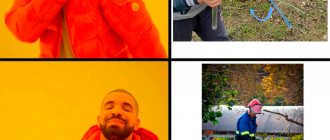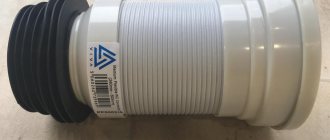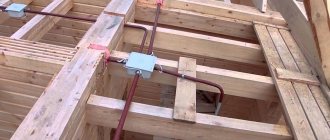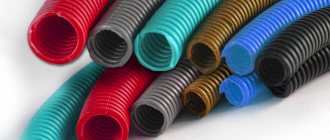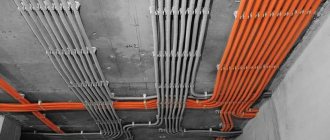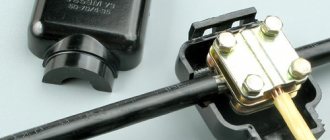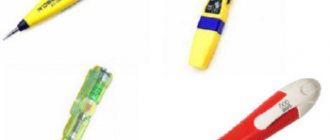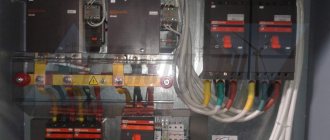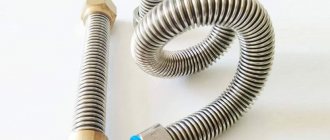When carrying out electrical installation work, it is often necessary to lay electrical wiring in an open way. To ensure protection of the electrical cable from mechanical influences, precipitation and other factors, to make a neat and aesthetic installation of power or low-current networks, a corrugated tube or, as it is also called, corrugation is used.
What is corrugation and where is it used?
An electrical installation corrugation is a corrugated pipe for laying an electrical cable for the purpose of protecting it or protecting structures. Laying electrical cables in corrugated tubes is used in various situations with open or hidden electrical wiring.
Hidden gasket
Hidden installation is the installation of electrical wiring inside the structures of walls, floors and ceilings, behind finishing materials. It is conventionally divided into the following types of installation:
Laying inside non-combustible structures is carried out in grooves of walls and ceilings, in floor screeds or simultaneously with the installation of load-bearing structures (for example, when concreting). In this case, corrugation is used for ease of installation, protection from cable crushing and the ability to replace electrical wiring without disturbing the finishing material, chipping or dismantling wall, ceiling or floor structures. When laying corrugated cables inside structures made of non-combustible materials, the PUE allows the use of any type of corrugated tubes.
Laying behind finishing materials or in false spaces has purposes similar to laying in non-combustible structures (protection from mechanical damage, the ability to replace wiring if necessary), but with the installation requirements being met, as when laying over combustible materials. The fact is that finishing materials often promote combustion, so the requirements for such installation are quite strict. It is important to use flame retardant or metal corrugations for such installation.
Underground installation is carried out during landscaping work for wiring electrical power lines to lighting fixtures and various equipment (sprinkler pumps, gate and door opening systems), when laying low-current networks for security systems or telephone lines, and in other situations. The main requirement for such installation of corrugated electrical cables is water resistance and high resistance to mechanical deformation (rigidity).
Some features
Returning to the first disadvantage of floor wiring, we emphasize that the specifics of installing electrical wiring of any type are clearly stated in the document PUE (“Electrical Installation Rules”). The main point is the availability of the entire system for inspection and repair work.
The points where wires connect/split must be free from mechanical tension from the material covering the floor. For this reason, various pipes made of corrugated, metal or polyethylene are used. The surface of this product takes the load of the coating. Remember that there must be enough free space inside for the wire to move.
One of the main elements of the electrical network in the house are distribution boxes. But placing them under the flooring is unrealistic, so the products are mounted in the wall. It is important to choose the correct height above the floor to avoid short circuits when the apartment is partially flooded and to prevent free access for children.
Since the corrugated pipe used for wiring must be smooth, in most cases it can be replaced with a regular polyethylene pipe with the appropriate diameter. However, the final decision is entirely up to you. Metal, corrugated and plastic products differ in technical characteristics and cost per linear meter.
PVC pipes for cable laying
Varieties based on material of manufacture
Corrugated tubes for electrical cables are made of metal or special plastic. Corrugations made from the following materials are widely used in construction:
Polyvinyl choride (PVC) is a lightweight material with self-extinguishing properties. Corrugations made from this material are made in gray color. PVC corrugated cables are used in dry indoor areas, as they are sensitive to ultraviolet radiation and are not waterproof. They are most widespread due to their availability (low price) and versatility of use.
Polypropylene (PPR) is a material that does not support or propagate combustion and is resistant to ultraviolet radiation. Corrugations made from this material are waterproof and are used when laying networks outdoors or in rooms with high humidity. The color of these corrugations is blue.
Low-density polyethylene (HDPE) is a moisture-resistant material. Such tubes are also used in damp rooms or outdoors. HDPE is a flammable material, so it is not used in wooden premises. The use of corrugated HDPE in screeds or in structures made of non-combustible materials is permitted. Available in orange or black.
Advantages of corrugation
When carrying out work related to electricity, safety requirements play an important role and should not be ignored. The cable must be placed in a corrugation, regardless of whether the wiring is planned under a concrete screed or under a wooden covering. In wooden buildings, a metal hose can be used.
Wiring under the floor can be done without corrugation if you are going to embed it in concrete, however, if the cable is damaged, it will no longer be possible to pull it out, and the corrugation will allow you to remove the old cable and place a new one in its place. When repairing wiring, you won't have to destroy the floor or run wires in a new location.
How to choose corrugation for wiring
To select a corrugation, you need to know the diameter of the electrical cable and the conditions under which the corrugated pipe will be laid. When choosing a diameter, consider the following recommendations:
- Corrugations with a diameter of 16 mm are used for lighting cables, switches or signal lines;
- corrugations with a diameter of 20-25 mm are used for sockets or for laying coaxial cable;
- for connection to distribution boxes, depending on the cable cross-section, from 25 to 32 mm;
- for laying cables to electrical panels, corrugation with a diameter of 32 mm should be used;
- for large cable diameters, corrugations with a diameter of 40 mm and above are used.
An indicative table of the dependence of the corrugation diameter on the cross-section and number of cores of an NYM or VVG electrical cable is presented below:
| Electrical cable cross-section, mm² | Number of cores, pcs | External diameter of corrugation, mm |
| 1,5 | 2/3/4/5 | 16/16/20/20 |
| 2,5 | 2/3/4/5 | 16/16/20/25 |
| 4 | 2/3/4/5 | 20/20/25/25 |
| 6 | 2/3/4/5 | 20/25/32/32 |
| 10 | 2/3/4/5 | 25/32/32/40 |
| 16 | 2/3/4/5 | 32/32/40/40 |
| 25 | 2/3/4/5 | 32/40/50/50 |
When choosing a corrugation, it is especially important to focus on the conditions in which the corrugated pipe with an electric cable will be installed and operated. Each material is suitable for different installation options. Briefly indicate the following materials and conditions for their use:
- PVC: dry and closed areas;
- PPR: wet rooms, street, underground installation;
- HDPE: wet rooms, street, underground installation;
- Metal: in any conditions;
- PA: in any conditions.
Safe installation
The wire must be solid, individual sections must be connected by distribution boxes. Make sure that the wiring is installed without twists: this reduces its reliability to a minimum. The boxes are removed and mounted above the floor covering. They can be placed in the wall, at a minimum height from the floor.
The box can also be placed on the floor, but to do this you will need to equip it with a special lid, which, if necessary, can be opened and the contents of the box can be easily accessed. To easily find a cable or wiring node of interest, it is recommended to create a diagram on which you can mark all the most important places.
An important condition is filling the corrugation. Do not put too many wires in it. The main space, which is 60%, should remain empty. The main wire route should not be more than 20 meters: this means the distance from the outlet to the panel. If the cable is located at a right angle, do not make more than two turns. This rule also applies to cables bent at sharper angles. Sharp bends should be avoided whenever possible. For a wooden house, please note that laying wiring directly along the joists is unacceptable.
Installation must take place through technical holes that can be drilled. It is recommended to treat wooden elements with a special composition that prevents combustion. In addition, you should not branch the route from the shield; this method will significantly complicate repairs if the electrical cable is damaged.
Recommendations for installation work
Inserting the cable into the corrugation
The cable is laid in a corrugated pipe using a special string installed by the manufacturer inside the corrugation. The sequence of work when laying an electrical cable in a pipe is as follows:
- The corrugated pipe is stretched over a long straight section. In order to tighten the cable inside the corrugation, you need to have a large space for complete unwinding.
- The end of the electrical cable is connected to the string, the connection point is wrapped with electrical tape for free movement without snagging the wire inside the pipe.
- A minimum of two people are required to complete this work. One person holds the corrugated pipe at one end, the second carefully and without jerking pulls out the string with the electric cable.
- After the cable has appeared on the back side of the corrugation, it is fixed (for example, with electrical tape) on both sides so that it does not jump into the corrugation again.
Fastening corrugated pipes
When installing a corrugated pipe with an electric cable, a variety of fastening methods are used. The most common of them:
- installation using plastic clips: used for installation on any type of structure;
- installation using dowel clamps or dowel pins: used when installing corrugations on concrete and wooden structures;
- installation using plastic ties to a metal cable or frame: used when laying corrugation on the street or in the presence of a metal frame (for example, in plasterboard ceilings);
- installation in grooves with subsequent sealing: used in concrete and brick walls, in plaster.
Places where it is beneficial to use the method
Electrical wiring on the floor is convenient in houses that have not yet undergone any renovation. Such buildings include newly erected new buildings, where, as a rule, only pre-finishing has been done. You will not have to violate the integrity of the walls; the cable can be laid in a place convenient for you in the floor, and the necessary wiring can be made from it to switches and sockets.
Installation under the floor will also be a profitable solution for a wooden house. In this case, wiring disadvantages associated with difficult access will disappear. For a wooden house, this solution is quite relevant, since running cable ducts along the walls will significantly affect the interior of the rooms, and retro-style wiring will cost much more than modern wiring.
By placing the cable under the floor, you will not only hide all the wires and make the wiring convenient, but if necessary, you can easily pull it out from under the boards and make repairs.
